jetcityimage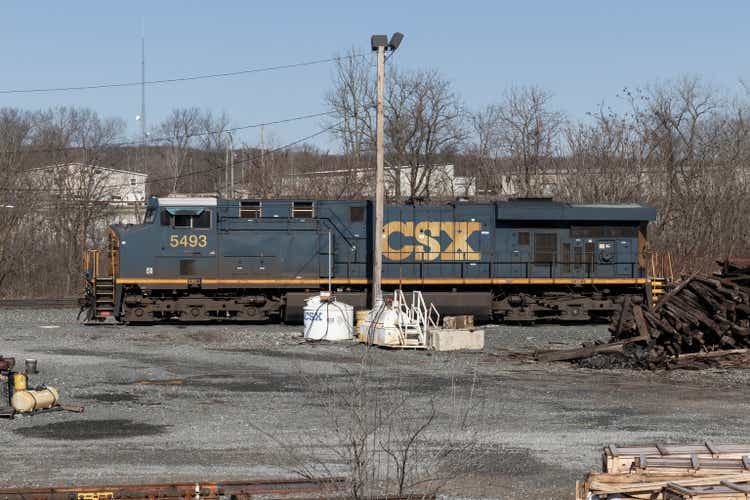
Introduction
A great deal of economic uncertainty for the wider US economy was removed when a tentative agreement was reached between union workers and railroads last week. Now that there is some medium-term clarity between management and labor, it seems like a reasonable time to review CSX’s (NASDAQ:CSX) stock valuation for investors. My last two CSX articles were written a few years ago. The first was a “Sell” article, written on June 13th, 2019, titled “CSX Corp: A 10-Year, Full-Cycle Analysis“. In that article, I suggested investors sell CSX due to its high valuation and then buy the stock back in at a lower price. That lower price came during the COVID crash, and on March 11th, 2020, I followed my earlier article up with “Revisiting My Bearish CSX Sentiment“. In that article, I gave investors who liked CSX and who may have rotated out of the stock after my first article the go-ahead to rotate back in since it was trading a little below fair value. Here is how CSX stock performed in between by “Sell” article and my follow-up article.
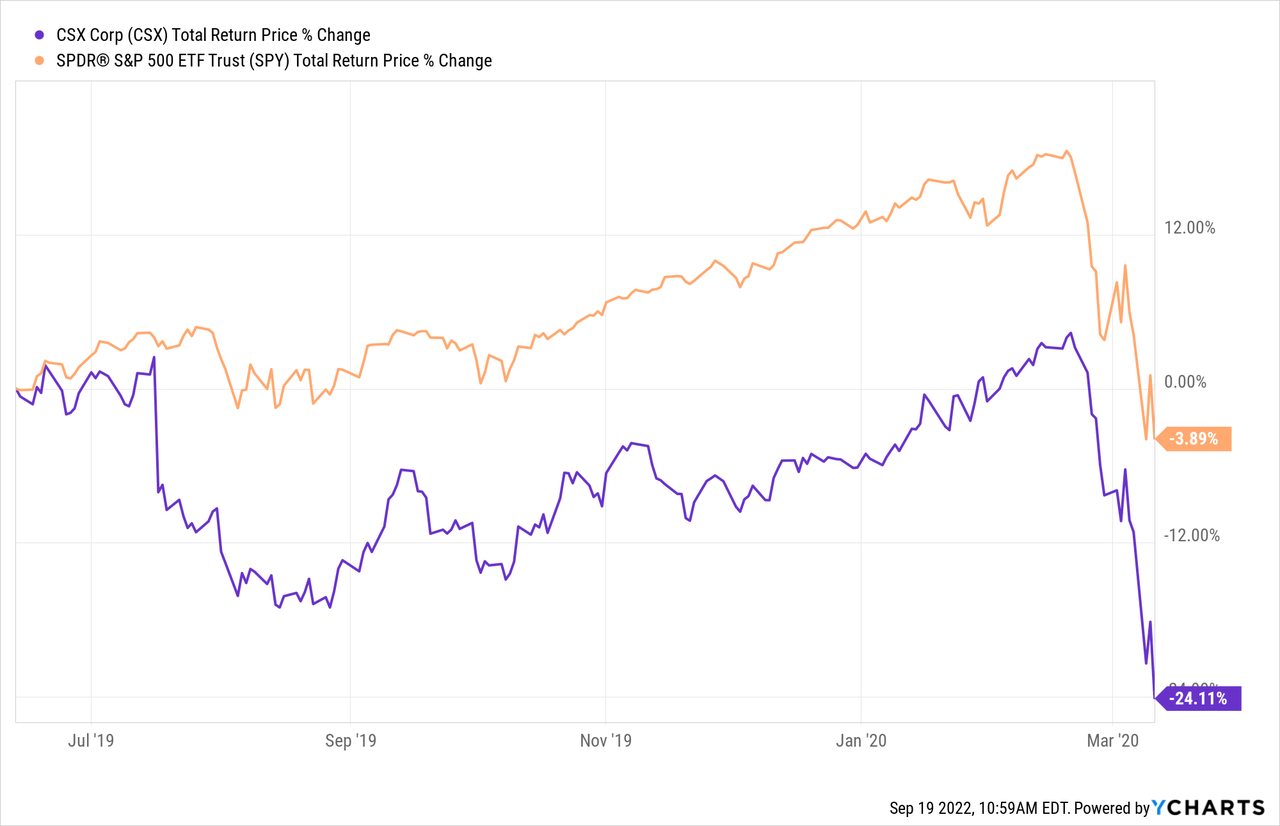
As we can see, CSX underperformed significantly during the time it was overvalued, even relative to the S&P 500 index. Since my last “rotate-back-in” article was written in March of 2020, here is how CSX has performed.
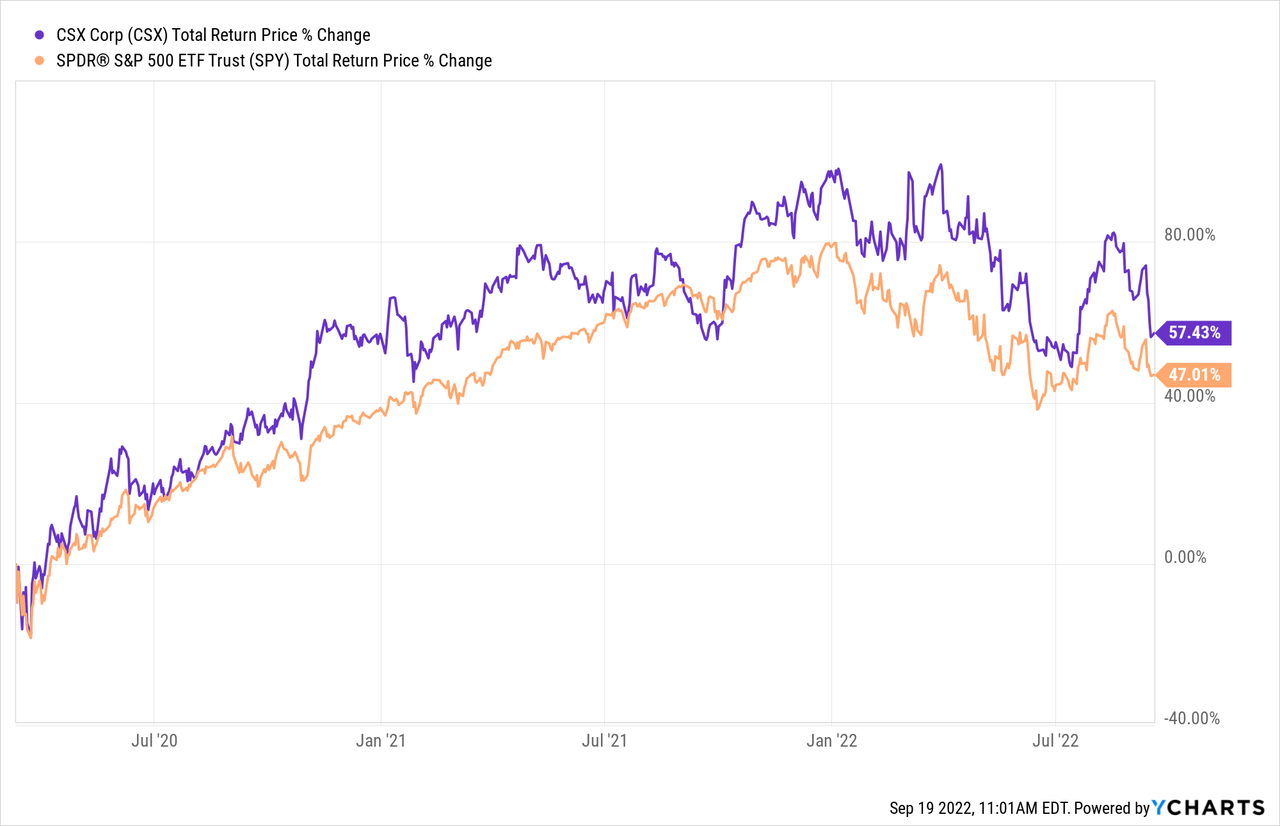
When an investor doesn’t overpay for the stocks they buy, they tend to perform relatively well. Because I like to have a margin of safety that goes beyond simply buying at fair value, CSX stock never fell quite deep enough for me to buy in March of 2020 (but it got pretty close).
In this article, I’m going to use the same valuation method I used in the previous two articles in order to see how CSX stock is valued today since the stock has fallen a bit off its high.
My Valuation Method For CSX
The valuation method I use for CSX first checks to see how cyclical earnings have been historically. Once it is determined that earnings aren’t too cyclical, then I use a combination of earnings, earnings growth, and P/E mean reversion to estimate future returns based on previous earnings growth and sentiment patterns. I take those expectations and apply them 10 years into the future, and then convert the results into an expected CAGR percentage. If the expected return is really good, I will buy the stock, and if it’s really low, I will often sell the stock. In this article, I will take readers through each step of this process.
Importantly, once it is established that a business has a long history of relatively stable and predictable earnings growth, it doesn’t really matter to me what the business does. If it consistently makes more money over the course of each economic cycle, that’s what I care about — numbers over stories.
Since 2005, CSX has experienced three years when earnings growth was negative, the deepest being 2009 when EPS growth fell -18%. This is representative of a moderately cyclical stock and the declines are shallow enough that I can perform an earnings-based analysis for the stock, so I will proceed with my standard “Full-Cycle Earnings” analysis. (If EPS had experienced really deep historical declines, I would use a different sort of analysis.)
CSX Stock – Market Sentiment Return Expectations
In order to estimate what sort of returns we might expect over the next 10 years, let’s begin by examining what return we could expect 10 years from now if the P/E multiple were to revert to its mean from the previous economic cycle. For this, I’m using a period that runs from 2015-2022.
CSX’s average P/E from 2015 to the present has been about 19.76. (the blue number circled in gold near the bottom of the FAST Graph). Using 2022’s forward earnings estimates of $1.89, CSX has a current P/E of 15.64. If that 15.64 P/E were to revert to the average P/E of 19.76 over the course of the next 10 years and everything else was held the same, CSX’s price would rise and it would produce a 10-Year CAGR of +2.37%. That’s the annual return we can expect from sentiment mean reversion if it takes 10 years to revert. If it takes less time to revert, the return would be higher.
Business Earnings Expectations
We previously examined what would happen if market sentiment reverted to the mean. This is entirely determined by the mood of the market and is quite often disconnected, or only loosely connected, to the performance of the actual business. In this section, we will examine the actual earnings of the business. The goal here is simple: We want to know how much money we would earn (expressed in the form of a CAGR %) over the course of 10 years if we bought the business at today’s prices and kept all of the earnings for ourselves.
There are two main components of this: the first is the earnings yield and the second is the rate at which the earnings can be expected to grow. Let’s start with the earnings yield (which is an inverted P/E ratio, so, the Earnings/Price ratio). The current earnings yield is about +6.40%. The way I like to think about this is, if I bought the company’s whole business right now for $100, I would earn $6.40 per year on my investment if earnings remained the same for the next 10 years.
The next step is to estimate the company’s earnings growth during this time period. I do that by figuring out at what rate earnings grew during the last cycle and applying that rate to the next 10 years. This involves calculating the historical EPS growth rate, taking into account each year’s EPS growth or decline, and then backing out any share buybacks that occurred over that time period (because reducing shares will increase the EPS due to fewer shares).
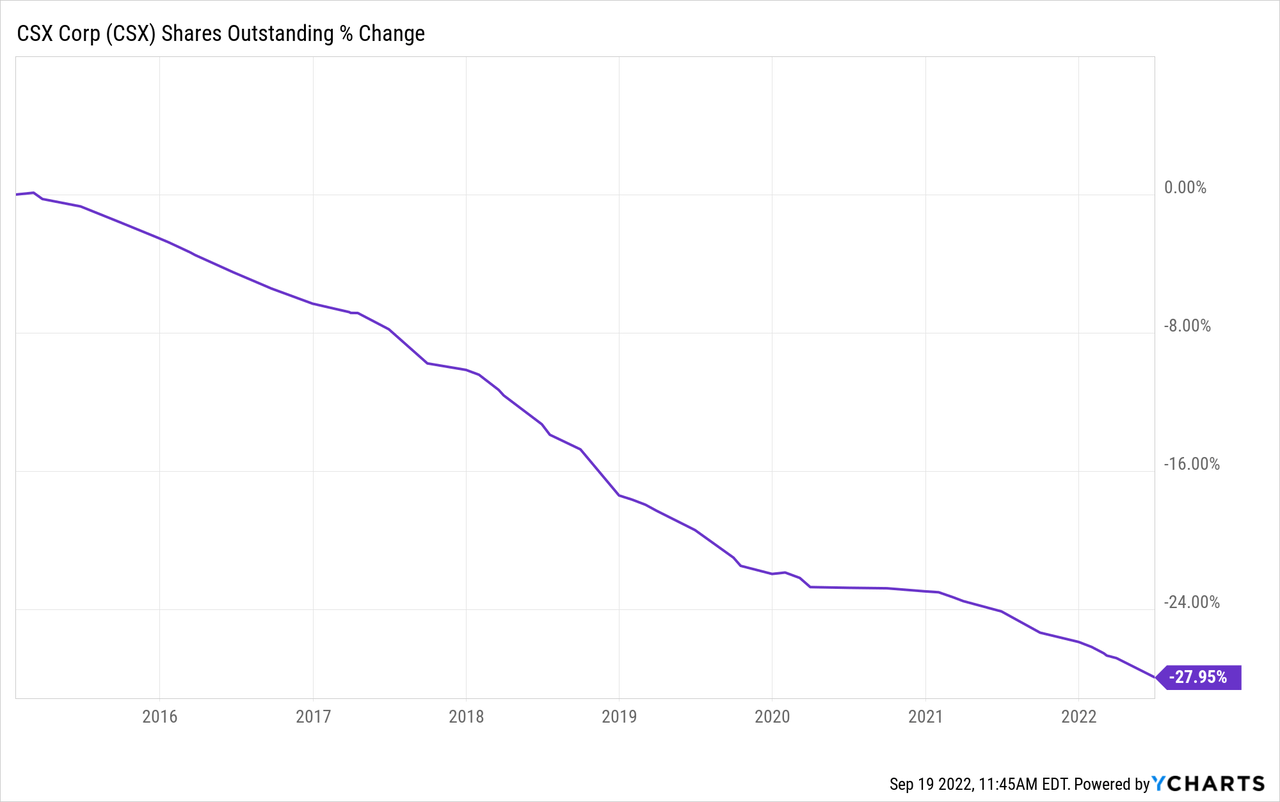
CSX has bought back a lot of stock since 2015, with nearly 28% of the company’s stock repurchased. I make adjustments to control for the effects these repurchases have on EPS in order to get an estimate for what rate earnings are organically growing. When I also control for both the share buybacks and for the two negative EPS growth years, I get an estimated earnings growth rate for CSX during this period of +9.85%. (Note that this is quite a bit more conservative than the FAST Graph calculation of +12.92% during this time.) And, I actually think my estimate is probably optimistic because 2018 was a year of big corporate tax cuts, and the 2020 recession was relatively mild (or at least quick) thanks to all the government stimulus. It is unlikely the stimulus and tax cuts will be repeated during the next cycle.
Next, I’ll apply that growth rate to current earnings, looking forward 10 years in order to get a final 10-year CAGR estimate. The way I think about this is, if I bought CSX’s whole business for $100, it would pay me back $6.40 plus +9.85% growth the first year, and that amount would grow at +9.85% per year for 10 years after that. I want to know how much money I would have in total at the end of 10 years on my $100 investment, which I calculate to be about $211.44 including the original $100). When I plug that growth into a CAGR calculator, that translates to a +7.78% 10-year CAGR estimate for the expected business earnings returns.
10-Year, Full-Cycle CAGR Estimate
Potential future returns can come from two main places: market sentiment returns or business earnings returns. If we assume that market sentiment reverts to the mean from the last cycle over the next 10 years for CSX, it will produce a +2.37% CAGR. If the earnings yield and growth are similar to the last cycle, the company should produce somewhere around a +7.78% 10-year CAGR. If we put the two together, we get an expected 10-year, full-cycle CAGR of +10.15% at today’s price.
My Buy/Sell/Hold range for this category of stocks is: above a 12% CAGR is a Buy, below a 4% expected CAGR is a Sell, and in between 4% and 12% is a Hold. A +10.15% CAGR expectation makes CSX a little undervalued here, but still a “Hold”.
My basic, non-recession buy price for CSX is $26.32, which is about -11% lower than where the stock trades right now. So, if you generally think CSX can continue their earnings trend since 2015 into the future and you don’t think we will experience a recession in the next 18 months, then that is a pretty good price to start buying the stock. I, however, think we are likely to experience a recession in the US in 2023, so, at least over the next 2 or 3 quarters, I will be demanding a lower price before I buy.
Additional Considerations: Recession P/E
Due to an ending of federal government stimulus and the Federal Reserve raising interest rates, I think there is an above-average chance that the US economy experiences at least a mild recession as soon as Q1 2023. This can typically mean two things for a stock. First, it can mean that EPS disappoints, and instead of growing 5% in 2023 as analysts now expect, EPS could fall. Judging from CSX’s historical EPS declines, I think assuming a decline as large as -20% is reasonable. The second thing worth paying attention to is how much the market typically discounts these falling earnings. I call this metric the “Recession P/E” and it is the low monthly P/E that the stock has experienced during past recessions. This can help us predict how low the P/E might go in a future recession.
In the 2008/9 recession (which was very bad) CSX’s recession P/E was 6.34. During the very quick 2020 recession, the recession P/E was 12.29. There is a pretty big difference between these two P/Es. My base case is that if we do experience a recession in 2023 it will probably be relatively mild, but it could last a while. In that sense, I expect it to be somewhere between the 2009 and 2020 recessions. So my estimate for the potential 2023 recession P/E for CSX is a simple average of these two previous recessions, which works out to a 9.31 expected recession P/E, should we have one.
For me, the recession P/E serves two functions. The main one is to keep me from buying the stock before earnings expectations disappoint. As I noted earlier, right now earnings are expected to grow next year at a 5% rate, if we have a recession EPS will likely fall double-digits instead. Often the stock market will anticipate this decline in earnings before it is officially reported, and the stock price will drop, thereby making the valuation look very attractive at the beginning of a decline. However, those hopes of earnings holding up as expected should we have an economic slowdown, will be dashed if earnings growth goes negative, and often at that point, the stock price falls even deeper. So, using the “Recession P/E” as a guidepost often helps keep me from buying too early before those earnings and earnings growth expectations come down.
However, if the stock happens to get really cheap, even in the face of a recession, it would likely hit that recession P/E and I could be a buyer well before any good news comes to the stock, yet hopefully with a significant margin of safety. This recently happened with Netflix (NFLX) stock back on May 6th of this year. It got so cheap, that even if there was a recession Netflix stock was a good deal, so I bought Netflix earlier this year using the same recession strategy I’m using with CSX.
I currently have CSX’s recession buy price around $17.77, or about -40% lower than the current price. I will probably keep this factor in effect until Q2 2023 when either my recession expectation is proven wrong, or until earnings expectations come down enough that they reflect a slower economy.
Conclusion
I want to briefly share some thoughts on the potential railroad strike that looks to have been averted. Reports are that workers will receive a 24% wage increase over 5 years, which is retroactive back to 2020 along with some other benefits that have more to do with working conditions and time off than money. On the surface, this deal seems fair, given we are now in an inflationary environment, however, from an investor’s standpoint, it should probably be viewed as a slight negative in the near term because it looks like workers will receive backpay right away. That means it’s likely railroad earnings were at least a little inflated the past two or three years, and now that money could come out of near-term earnings unless it has already been accounted for. In the end, it doesn’t really influence my investing behavior here, but it is worth noting there could potentially be a near-term drag on earnings growth that is unrelated to the wider economic cycle.
Given what we currently know about the economy and based on CSX’s performance since 2015, the stock is fairly valued at today’s price. However, if we have a recession in the near future, I think there is an above-average chance of a -25% to -45% decline in the stock price. Since I am currently in the camp of those who think at least a mild recession is likely as soon as Q1 2023, and because I prefer to have a margin of safety when I buy a stock, I will not be buying CSX stock unless the price is significantly lower during the next 6 months or so.


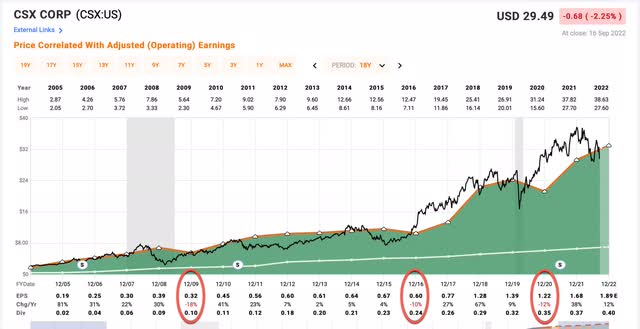
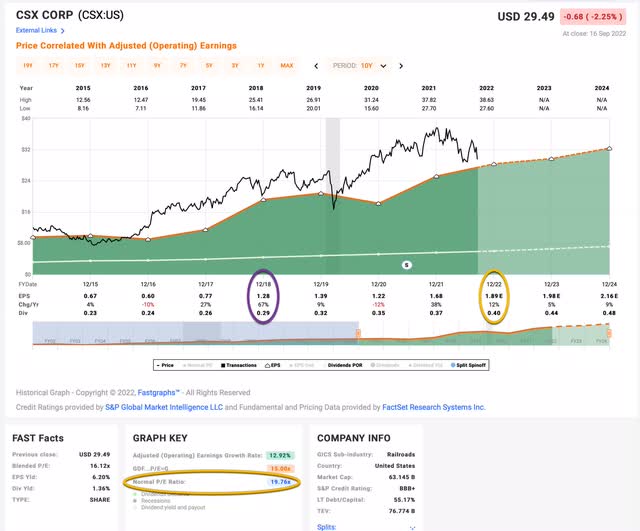
Be the first to comment